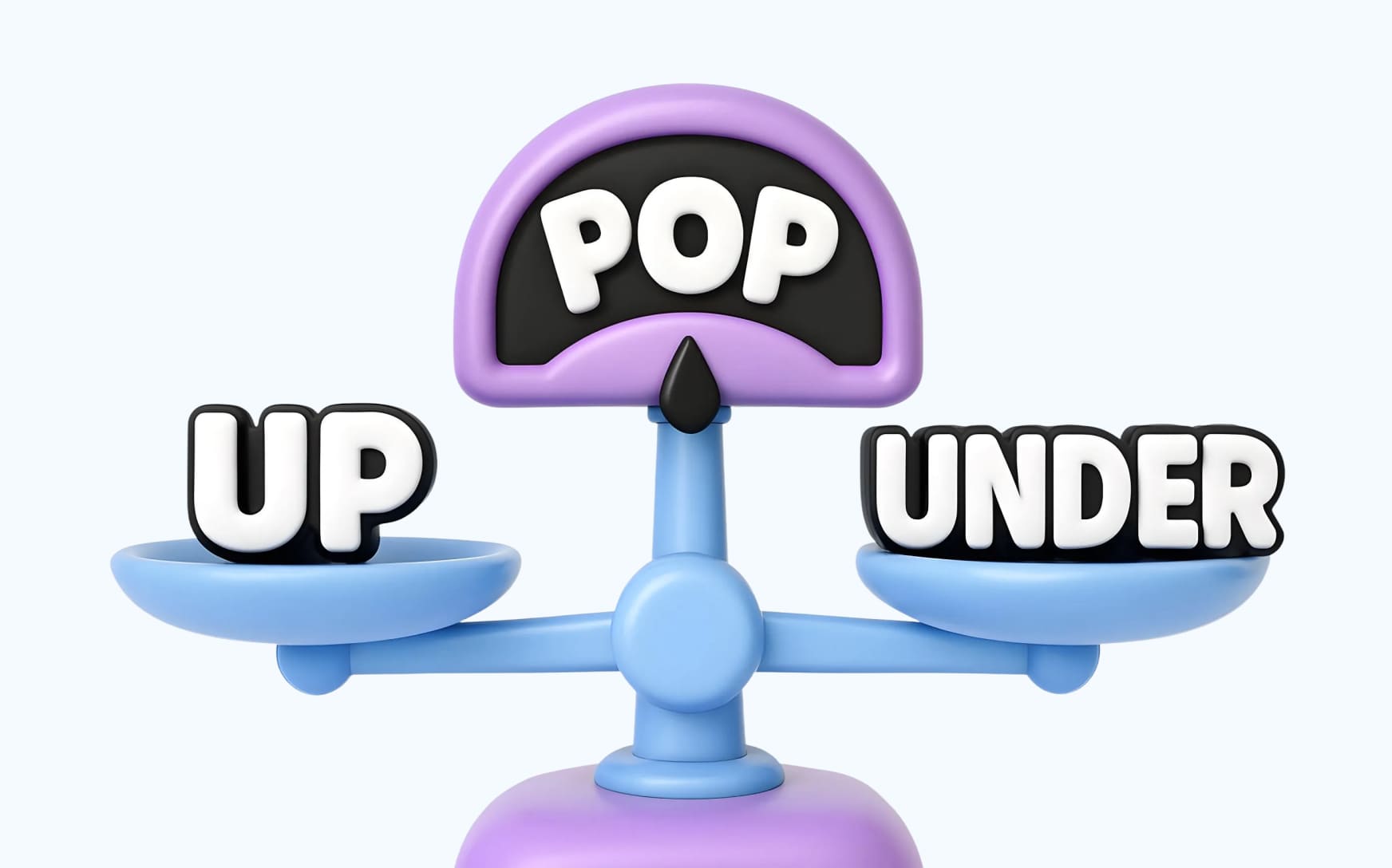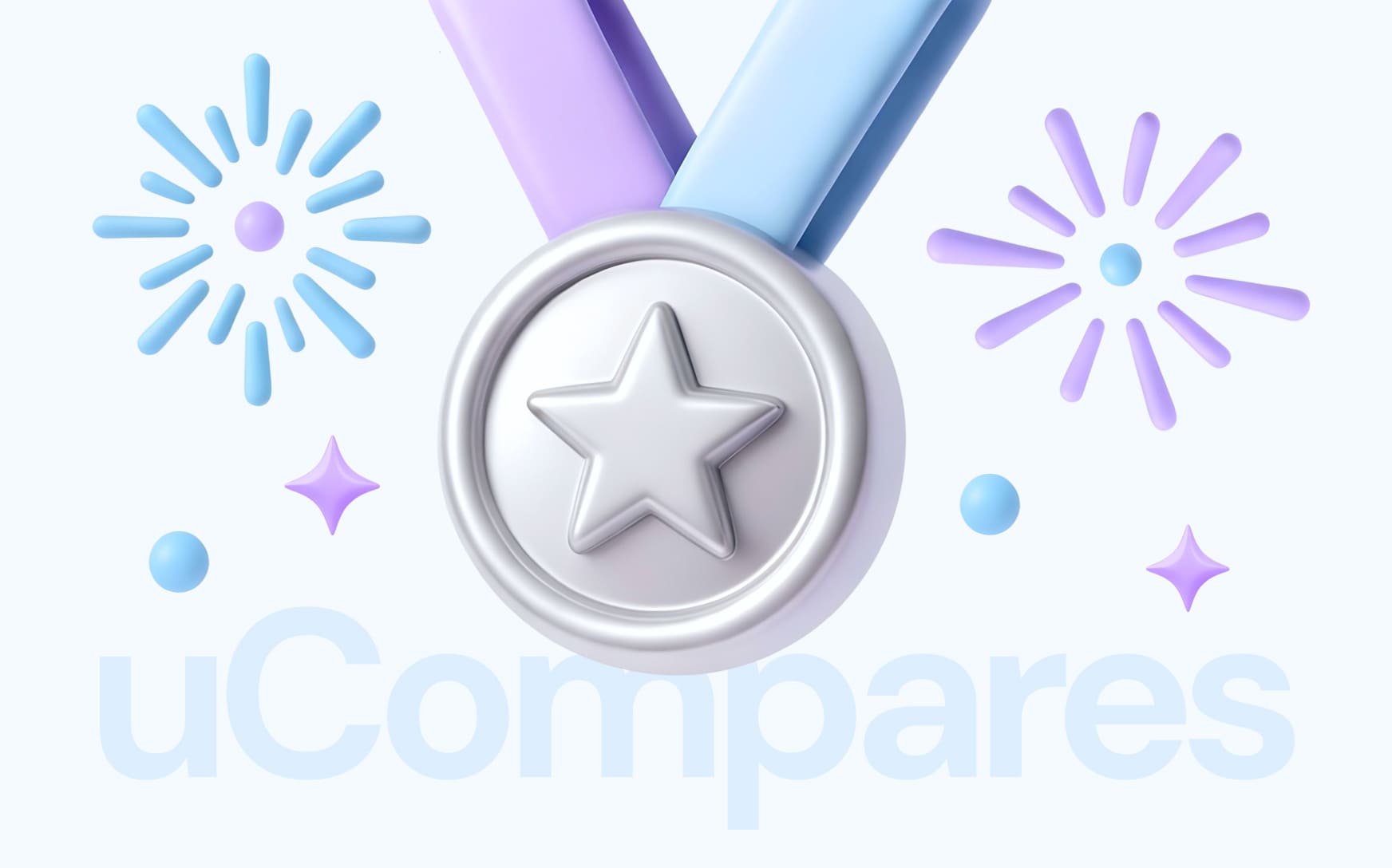Pop Advertising
Wondering what is pop advertising and how it fits into modern affiliate campaigns? You’re not alone. Despite being one of the oldest digital formats, pop ads are still very much alive — and performing.
This traffic type is known for its simplicity, reach and power to drive instant visibility. Whether it’s pop-up or popunder, affiliates continue to use it to promote challenging verticals and scale fast.

But what exactly are pop ads? How do they work and why do they remain so popular in 2025? In this guide, we’ll break down the pop advertising definition, explore how it works in affiliate marketing, share top use cases and explain why it should be in your media buying strategy.
Let’s start with the basics — what are pop ads and how are they different from other formats?
Pop Advertising Definition: What Are Pop Ads?
So, what is pop advertising, and how is it used in 2025?
Pop ads are full-page browser-based ads that appear automatically when a user visits or interacts with a website. They don’t rely on banners, headlines or visuals — instead, they redirect users straight to a landing page, making them one of the most aggressive and direct ad formats available.
What Is a Pop Ad?
A pop ad (short for “pop advertisement”) is triggered by user behavior — usually a click or page load. It opens a new browser window or tab that immediately displays a promotional page, affiliate offer or product.
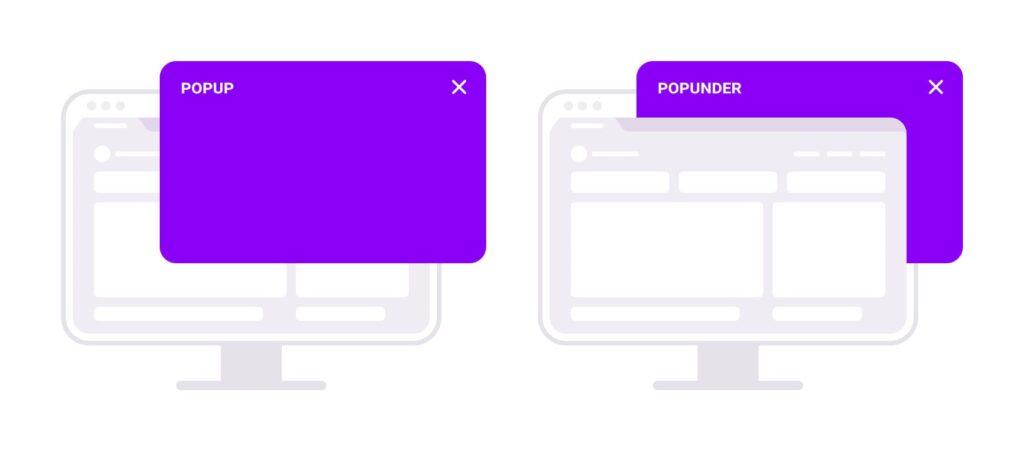
There are two core formats:
- Pop-up – opens on top of the user’s current screen.
- Popunder – opens under the active window or in a new background tab.
However, it’s worth noting that classic pop-ups are rarely used anymore. Most browsers block them by default, and they tend to annoy users — which leads to high bounce rates and poor engagement. Because of this, popunder ads have become the dominant format in modern pop advertising.
Pop vs Popunder: Are They the Same?
In the world of affiliate marketing, the terms pop and popunder are often used interchangeably. When media buyers or ad networks talk about “pop traffic”, they usually mean popunders by default — the format that bypasses ad blockers more reliably and provides smoother user experiences.
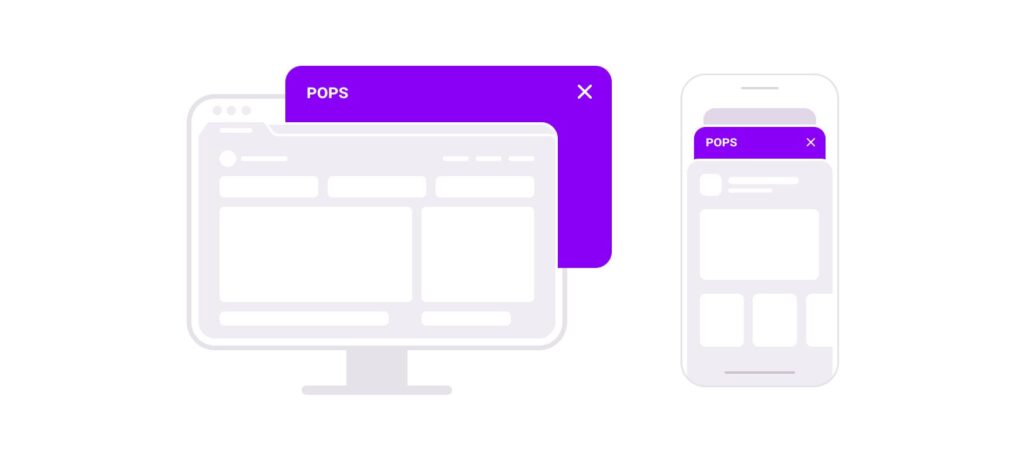
Here’s a quick comparison:
| Feature | Pop-up | Popunder |
| Display | In front of active browser | Behind or under active window |
| Visibility | Immediate | Delayed until tab/window switch |
| Blocked by Browsers | Frequently | Less frequently |
| User Experience | Often intrusive | Subtle and less disruptive |
💡Pop advertising meaning is often misunderstood. It’s not just random windows — it’s a smart way to drive targeted traffic to offers without creative fatigue. In 2025, when affiliates say they’re running a pop campaign, they almost always mean popunder traffic.
Ready to dive deeper? Let’s look at how this traffic type works technically — and why it’s still relevant.
How Do Pop Ads Work?
Now that we’ve clarified that modern pop ads in affiliate marketing are essentially popunders, let’s look at how this traffic format works in practice.
Unlike banner or native ads, that require a user to notice and click, pop traffic works automatically. The user simply performs a basic action — like clicking anywhere on a page — and a new browser tab or window is triggered in the background, loading a full-page offer.
Pop Traffic Meaning in Action
Here’s a simple breakdown of how pop traffic works:
- A user lands on a publisher’s website that’s monetized with pop ads.
- When the user clicks, scrolls or interacts with the page, a script opens a new tab (or window).
- That tab shows your affiliate landing page, hosted offer or product page — instantly.
- The user continues to browse and sees the offer when they switch tabs or close their current session.
Because of this flow, popunder ads don’t interrupt the user right away. That makes them less intrusive, more browser-friendly and better for engagement than old pop-ups.
📌 Pop traffic meaning: a stream of visitors delivered via automatically triggered tabs or windows — to show full page offers without needing banner clicks or creatives.
The Role of Ad Networks
These campaigns are launched through self-serve ad networks like ROIads where advertisers.

- Set a CPM bid,
- Choose targeting options (geo, OS, device, etc.),
- Upload a landing page URL,
- And start getting traffic from a global pool of publisher sites immediately.
The result? Huge traffic volumes, super low CPMs and super fast testing — that’s what makes pop ads in affiliate marketing so scalable.
Now let’s break down how affiliates use pop traffic to drive real conversions.
Pop Ads in Affiliate Marketing
Pop ads in affiliate marketing are all about fast traffic, fast testing and fast results. For many media buyers, pops are the go-to format when it comes to launching aggressive verticals, collecting data quickly and scaling winning offers without creative burnout.
Unlike banner or push ads, pops don’t need visuals or headlines. You simply drop your landing page URL in the campaign — and it gets shown to thousands of users, often within minutes. That’s why it’s one of the easiest and most accessible ad formats for affiliate marketers, especially beginners.
Why Affiliates Love Pop Traffic
Here’s why pop advertising is one of the top choices in performance marketing.

- Massive volumes: Pops are available on billions of websites globally. Ad networks like ROIads have over 900 million pop impressions daily.
- Low CPM rates: You can start with bids as low as $0.3 per 1000 impressions — perfect for split-testing and scaling.
- No creatives needed: No need to design banners or write ad copy — just launch with a strong landing page.
- Fast approvals: Pop campaigns go live faster than native or push, with fewer restrictions.
- Perfect for challenging verticals: Offers in gambling, betting, antivirus, sweepstakes and dating do well on pops.
💡 Many successful affiliates use pop ads for pre-landing testing, funnel validation or as a backup traffic source when other formats become too expensive or competitive.
When Pops Work Best
Pop traffic isn’t a magic bullet — but it works when used strategically. It works best when:
- You have a proven funnel that converts cold traffic,
- Your offer doesn’t require deep user intent,
- You’re targeting geos with less saturated markets (Tier 2, Tier 3),
- You can optimize by source using Micro bidding.
In short, pop ads give affiliate marketers a high-volume testing environment, low entry cost and flexibility that few other formats offer.
Advantages and Disadvantages of Pop Traffic
Like any ad format, pop traffic has its own set of pros and cons. It’s not for everyone — but if you know how to use it right, it can deliver big results.
Let’s take a closer look at the pop ads meaning from a performance standpoint.

Advantages of Pop Ads
- Massive traffic: Pop traffic is global. If you want millions of impressions fast, pop is the way to go.
- Ultra low CPMs: You can test with $10-$20 and still get enough data to make decisions.
- No creatives needed: No banners, text or videos — just a working landing page. This simplifies the whole funnel.
- Works for aggressive verticals: Pop is one of the few formats where gambling, betting, sweepstakes and antivirus offers are not only accepted but perform extremely well.
- Fast testing and scaling: Ideal for A/B tests, funnel experiments and pre-landing tests. Many affiliates use pops to validate offers before scaling with push or native.
- Bypasses banner blindness: Since users don’t have to click to see your offer, you’re not competing for attention — you already have it.
Disadvantages of Pop Ads
- Can be blocked by browsers or extensions: Some browsers and ad blockers prevent popunder windows from opening, especially in Tier 1 countries.
- No built-in prequalification: Unlike push ads where the user clicks, pops force exposure. So your landing page has to do all the work.
- Requires smart targeting: Without proper ad network optimization tools (like source-level bidding or frequency capping), you’ll waste budget.
Pop traffic meaning, in short: high-risk, high-reward. It’s raw, direct and often messy — but when done right, it can be one of the most profitable formats for affiliates.
Top Geos and Devices for Pop Ads
One of the reasons pop advertising still works is because it’s available in a wide range of geos and devices. From Tier 1 to Tier 3 markets, pop traffic offers scale, affordability and flexibility — as long as you know where to look.
At ROIads, our top-performing geos for pop ads are both high-competition and high-potential countries so you can balance cost and volume based on your funnel.
Best-Performing Countries for Pop Traffic
Here are the current top 6 geos for pop campaigns on ROIads, along with daily impressions and average CPM.

| Geo | Impressions per day | Average CPM |
| USA | 3,691,111 | $3.4 |
| Indonesia | 597,289 | $2.1 |
| Vietnam | 193,608 | $1.8 |
| Thailand | 170,618 | $1.8 |
| Pakistan | 74,546 | $2.8 |
| South Korea | 49,546 | $1.7 |
💡 Pro tip: If you’re testing pop ads for the first time, start with Vietnam, Thailand or South Korea — they offer a good balance between traffic cost and quality.
Desktop or Mobile?
Pop traffic works on both desktop and mobile, but performance varies by vertical. For example:
- Gambling and betting perform better on desktop, where the UX is more stable.
- Sweepstakes, software, and utilities see stronger conversions on mobile, especially in Tier 3 geos.
- Dating can go either way — depending on the offer and landing page layout.
Best Verticals for Pop Ads
Not all offers work with pop traffic — but for the right vertical, it’s a goldmine. Since pop ads show users a full landing page instantly, they’re perfect for offers that require immediate attention and low entry barriers.
Let’s break down the best verticals for pop ads by device type, based on real performance data from ROIads.
Top Verticals on Desktop
On desktop, users stay longer on pages and are more open to complex funnels — making it a great match for verticals that need more time to convert.

- Dating — pre-landings work great here; users are curious and tend to explore.
- Gambling — longer sessions and stable environments = better deposits.
- Media & Blogs — monetize through ads, push subscriptions or soft lead gen.
- Software & Apps — antivirus, VPNs, file converters, utility installs.
Top Verticals on Mobile
Mobile pop traffic is fast and impulsive. It works best for offers that don’t require long decision-making and can convert in a few taps.

- Gambling — quick funnel, high volume, solid ROI in Tier 3.
- Betting — perfect for match-based ads and time-limited promotions.
- E-commerce — simple one-product shops, dropshipping.
- Dating — lightweight landers and adult flows perform especially well.
💡 Remember: device targeting is key in pop ads in affiliate marketing. Always split-test mobile and desktop separately to see where your funnel performs best.
How to Launch a Pop Campaign
Launching a pop ad campaign is easy and beginner-friendly — but to make it profitable, you need a clear structure and the right tools. Here’s a step-by-step guide to help you get started and optimize effectively.
Most affiliates launch pop ads through self-serve ad networks like ROIads, where you control everything: bidding, targeting, sources and budget.
Step-by-Step Setup
- Choose an ad network: Pick a reliable platform that offers real-time stats, source-level data and tools like Micro Bidding.
- Set up your campaign: Select the Popunder ad format (often labeled as “Pop”). Choose your geo, device, OS and browser targeting. Upload your landing page URL — no creatives required. Set frequency caps (e.g., 1-2 impressions per user/day). Set your daily budget (start from $20–$50 for testing).
- Set your bid: Use the recommended CPM or start slightly higher to get quality traffic fast. Example: in the USA, pop CPMs may be around $3.4, in Vietnam — $2.2.
- Track your performance: Integrate a tracker (like Keitaro, BeMob, RedTrack) with your postback URL to track conversions, EPC and ROI.
- Start optimizing: Use Micro bidding to adjust bids by source, OS or region. Take whitelists/blacklists from your personal manager. Split-test landings, pre-landings and even browser types.
Bonus Tips for Success:
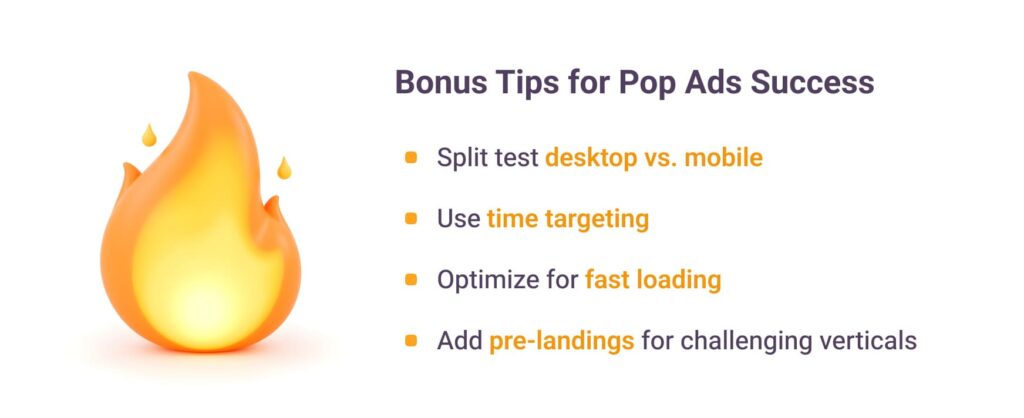
- Test separately on desktop and mobile — performance can vary dramatically.
- Set up time targeting based on user activity hours (e.g., evenings for gambling).
- Use landing pages that load fast — even 1 extra second can kill your CR.
- For aggressive verticals, use pre-landings to warm up users before the main offer.
Launching pop campaigns is fast — optimizing them is where the real work (and profit) happens.
Now, let’s wrap it up and see why pop ads are still relevant and profitable in 2025.
Why Pop Advertising Still Works in 2025
Despite the rise of AI-driven ad formats and stricter browser policies, pop advertising is still very much alive — and thriving. In fact, for many affiliates working in high-competition verticals, it remains one of the most reliable and scalable formats.
Here’s why pop ads still make sense in 2025:
1. Scale and Speed
Pop traffic delivers millions of impressions per day — instantly. You don’t have to wait days for moderation or approval. Want to launch a new offer this afternoon? With pops, you can.
2. Low Risk, High Testing Power
CPMs are still some of the lowest in the industry. You can test five funnels with $50 and get statistically meaningful results. It’s perfect for:
- Testing new landings
- Validating creatives (on other formats)
- A/B testing headlines, flows, or languages
3. Still Dominates Challenging Verticals
Pop ads continue to outperform other formats in niches like:
- Gambling and betting
- Antivirus and utilities
- Sweepstakes
- Dating
Why? Because these verticals don’t rely on user intent — they rely on exposure. And pop traffic guarantees exactly that: full, uncensored exposure at massive scale.
4. Advanced Tools Make It Smarter
Modern ad networks like ROIads offer optimization tools that didn’t exist when pops first took off:
- Micro bidding
- Traffic segmentation
- Real-time blacklisting
- Source-level stats
This turns what used to be a “blind” format into a precise machine for profit.
In Summary: What Is Pop Advertising and Why Use It
So, what is pop ad, and why should affiliates still care about it in 2025? It’s a no-nonsense, high-volume format that gives you instant visibility, zero creative fatigue and unmatched testing power. Whether you’re scaling a dating offer in Southeast Asia, launching a gambling funnel in the US or validating a new software landing page — pop ads get you live traffic now.
Yes, it’s aggressive. Yes, it needs smart optimization.
But it works — and it works fast.
Tired of overpaying for clicks, battling banner blindness or waiting days for approval — pop ads are your way out.
At ROIads ad network, we make it easy to get started:
- Launch your campaign in minutes
- Target high-performing pop traffic in Indonesia, Vietnam, USA, and beyond
- Tap into top verticals like iGaming, utilities, dating and antivirus
- Use built-in tools like Micro bidding and AI bidding technology to fine-tune performance
Still asking what is a pop ad? It’s your shortcut to scalable, no-nonsense affiliate revenue. Start your first campaign today — and turn raw traffic into real conversions.






